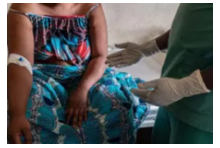Children are most at risk from the deadly Mpox virus | Children's Emergency Fund
de SAVE THE CHILDREN FEDERATION INCChildren are particularly vulnerable to the new strain of the deadly Mpox virus that is spreading globally after being declared a public health emergency of international concern by the World Health Organization (WHO).
According to the WHO, 70% of the Democratic Republic of the Congo (DRC) 14,901 cases are in children under 15, and 39% of the cases in children under five
Mpox causes fever, rash and lesions all over the body, severe headaches and fatigue. In severe cases, Mpox can lead to sepsis, a life-threatening response to infection that requires immediate specialist medical attention.
Some children also develop respiratory problems and have difficulty swallowing and are at higher risk for secondary bacterial infections.
Transmission might be driven by children’s weaker immune systems or the fact that children might have more physical contact interactions to school or playing with friends
Children may end up at higher risk due to the close resemblance of some of the signs and symptoms of Mpox to other common childhood illnesses, like scabies and chickenpox. This may lead to delay diagnosis in treatment.
How Save the Children is responding:
In DRC, we’re responding to the Mpox outbreak in North Kivu and South Kivu through water, sanitation, and health services support. This includes providing PPE and training leaders in engagement, communication, and community alert systems for identifying and reporting suspected cases.
Save the Children is also working with the national government in Burundi on a national response plan to the rising numbers of infections.
You can help by supporting the the Children’s Emergency Fund. Our Children’s Emergency Fund lets us speed relief to disasters around the world in the first 24 hours, when children’s lives hang in the balance. This could include deploying our Emergency Health Unit to provide free healthcare, distributing prepositioned supplies and setting up safe spaces to protect children.
